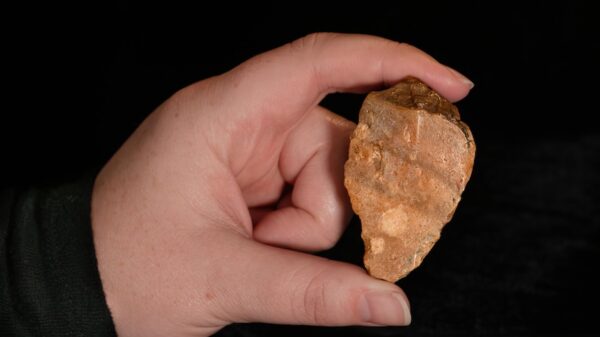Archaeologists have uncovered a significant discovery on the Indonesian island of Sulawesi: ancient stone tools that may belong to a previously unknown hominin population. These artifacts, dated between 1.04 million years and 1.48 million years old, suggest that early humans were capable of crossing deep ocean barriers, much like their relatives on the nearby island of Flores, known for the discovery of the diminutive Homo floresiensis, often referred to as ‘hobbits.’
The team, led by **Adam Brumm**, an archaeologist from Australia, and **Budianto Hakim** from the National Research and Innovation Agency of Indonesia (BRIN), found seven flaked stones at various depths below ground. The dating of local sandstone and a nearby fossilized pig helped establish the age of these tools, potentially marking them as the earliest evidence of human activity in the Wallacea region, a series of islands that have separated the Asian and Australian continents for millions of years.
New Insights into Early Human Migration
The identity of the toolmakers remains elusive, but Brumm believes the tools indicate that hominins may have reached Sulawesi by accident, possibly through natural “rafting” on vegetation mats, rather than through advanced maritime technology. He stated, “It’s highly unlikely these early hominins had the cognitive capacity… required to invent boats.” This assertion aligns with earlier research suggesting that small animals like rodents and monkeys may have made similar crossings from the Asian mainland to Sulawesi.
**Debbie Argue**, an archaeologist not involved in the study, emphasized the importance of the findings, noting that they contribute to the understanding of early Pleistocene hominins and their remarkable ability to navigate sea barriers. She remarked, “Island Southeast Asia is shaping up to be an extraordinary frontier for human evolution.”
Previously, the oldest known stone tools in Wallacea were found in Flores and dated at approximately 1.02 million years. This region is also significant for housing the remains of **Homo floresiensis**, discovered in 2003, which stood about one meter tall and had a brain the size of a grapefruit. The ancestors of this species are believed to have lived on Flores for at least 700,000 years.
The Search for Connections
While no hominin fossils have yet been found on Sulawesi, the presence of these stone tools strongly indicates that hominins inhabited the island. The late **Mike Morwood**, who co-discovered the ‘hobbit,’ speculated that Sulawesi might hold the key to understanding the origins of this unique species. Brumm echoed this sentiment, suggesting that Sulawesi could have served as a stepping stone for early humans traveling from mainland Asia to Flores.
The recent discovery has reignited interest in the broader implications of human migration in Southeast Asia. Brumm’s team now plans to explore Sulawesi further for direct remains of the ancient toolmakers and investigate younger sites to understand the interactions between these early hominins and modern humans, who are believed to have arrived on the island at least 65,000 years ago.
The findings were published in the journal **Nature**, adding to the growing body of evidence that highlights the complexity of early human migration and adaptation in the region. As more discoveries emerge, the narrative of human evolution in Southeast Asia continues to evolve, revealing a rich tapestry of interactions and movements long before modern humans arrived.





































































